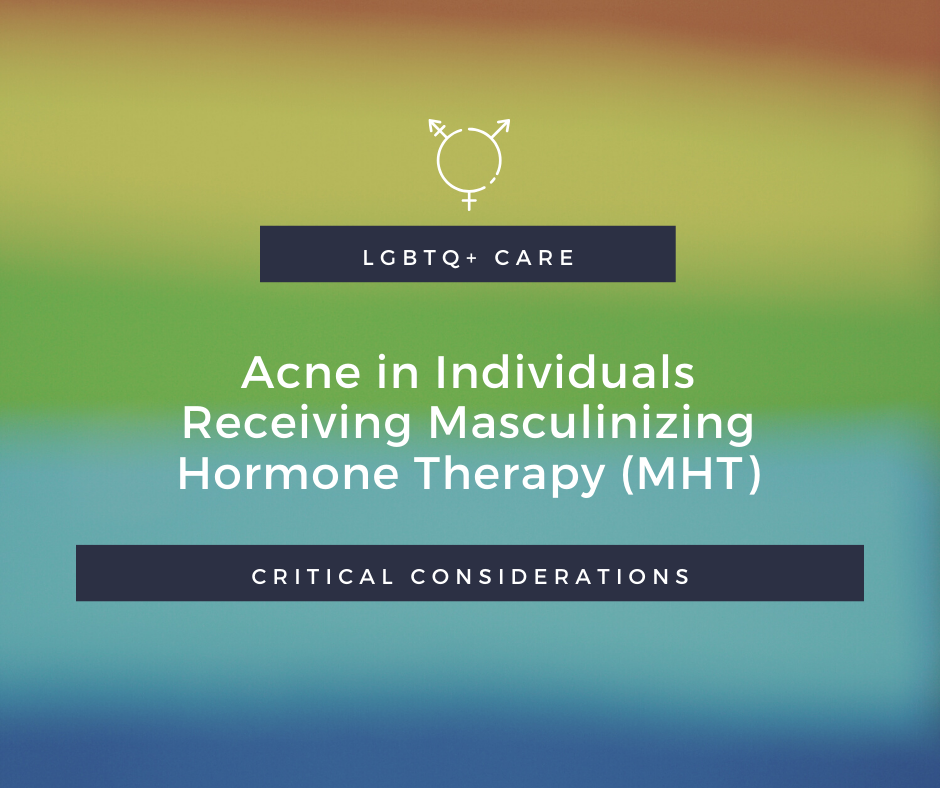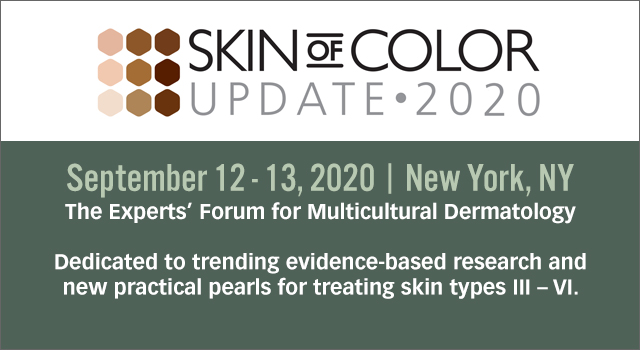Masculinizing hormone therapy (MHT) represents a common therapeutic intervention for transgender men (female-to-male) and other gender diverse individuals. MHT typically involves the use of one of several forms of parenteral testosterone (e.g. gel, patch, intramuscular, pellet).1 The goal of MHT is to help develop masculine secondary sex characteristics and/or suppress feminine characteristics in order to decrease gender dysphoria. MHT has been associated with some adverse effects including the development and/or worsening of acne vulgaris. This is likely mediated through the direct effects of testosterone at the pilosebaceous unit, leading to increased sebum production, a major component of the pathogenesis of acne vulgaris.
Current evidence on the prevalence and severity of acne with use of MHT remains limited. In a prospective cohort study of 20 Caucasian transmen, facial and back/chest acne was present in 82.4% and 88.2% of subjects, respectively, after 6 months of testosterone therapy.2 While most transmen in the study developed mild to moderate acne lesions, half required use of topical agents and/or oral antibiotics for acne treatment. Other case reports and series describe the development of severe acne in gender minorities receiving MHT, requiring isotretinoin therapy.3
While the American Academy of Dermatology’s guidelines for the care of acne remain largely applicable for individuals receiving MHT, there are several critical considerations for acne management unique to this population.
What should I know about the relationship between serum testosterone levels and acne vulgaris among individuals receiving MHT?
When assessing acne among individuals receiving MHT, it is important for physicians to review the dosing route and serum testosterone levels and, if needed, work closely with physicians managing their MHT to optimize their regimen. The normal physiologic range for serum testosterone in cisgender males varies widely (350-1100 ng/dl). Among individuals receiving MHT, serum testosterone levels greater than 630 ng/dl have been associated with an increased risk of developing acne vulgaris.4 Furthermore, certain dosing regimens, particularly the use of injectable testosterone with higher, less frequent dosing, can result in more drastic peaks of serum testosterone that can worsen acne. Dermatologists should work closely with providers prescribing MHT to optimize dosing regimens in order to minimize unwanted side effects such as acne vulgaris, while still adequately maintaining the gender-affirming goals of MHT.
Are there additional risk factors for acne development among individuals receiving MHT?
In addition to MHT, the practice of chest binding may contribute to the development of acne on the chest and back in some gender minority people. Chest binding, or binding for short, involves the use of a tight-fitting sports bra, ace or plastic wrap, duct tape, or designated binder to create a flatter chest contour. Particularly when an occlusive binding method (e.g. duct tape, plastic wrap) is used for an extended period of time in individuals with larger breasts, chest compression and occlusion can lead to the development of acne in addition to skin excess/ptosis, irritation, and/or infection. As chest binding is associated with increased self-reported mood and reduced gender dysphoria, clinicians should not routinely discourage the practice of chest binding. Instead, dermatologists should have an open conversation with individuals regarding both the positive and negative health outcomes associated with binding and may encourage individuals to take ‘off-days’ from binding and to avoid more occlusive methods like duct tape and elastic bandages.5
Is there an increased risk for pseudotumor cerebri among individuals receiving MHT?
Although the evidence is limited, there have been several recent case reports detailing an association of pseudotumor cerebri (PTC) with testosterone therapy.6,7 Independently, the use of tetracycline antibiotics and isotretinoin are also associated with PTC, albeit infrequently.8,9 Consequently, individuals receiving MHT should be routinely counseled on this potentially serious adverse event given the independent association of PTC with MHT, tetracycline antibiotics, and isotretinoin.
How do I register individuals receiving MHT in the current iPLEDGE program?
Currently, dermatologists are required to enroll individuals in the iPLEDGE program based on their sex/gender and reproductive potential. This classification system requires that individuals receiving MHT who were assigned a female sex at birth and are (1) of childbearing age, and (2) retain their ovaries and uterus, be registered as “female of reproductive potential” (FRP).10 Individuals receiving MHT assigned a female sex at birth who are either (1) post-menopausal, or (2) have received a hysterectomy or oophorectomy, can be registered as either “Male” or “Female not of reproductive potential” (FNRP). As this classification system does not always respect the individual’s gender identity nor offer an inclusive approach to care, advocacy efforts are underway to revise the iPLEDGE classification system to create sex and gender-neutral categories based solely on reproductive potential.11 Until these efforts are reflected in the registration system, dermatologists should have an open and empathetic conservation with gender minorities about the current requirements and limitations of iPLEDGE.
What contraception method is best for individuals receiving MHT and isotretinoin?
First and foremost, MHT does not represent an effective contraception method even if an individual achieves an amenorrhoeic state.12 It is therefore essential to understand the reproductive potential and sexual behaviors of individuals receiving MHT. Individuals receiving MHT assigned a female sex a birth who (1) are of childbearing age and (2) retain their ovaries and uterus should be registered as “Female of Reproductive Potential” (FRP). Those who engage in receptive vaginal intercourse with fertile male partners are further required to have two forms of contraception under the current iPLEDGE guidelines. Those who do not engage in receptive vaginal intercourse with fertile male partners can use “abstinence” as their sole form of contraception. Although individual preferences will vary, contraception options among individuals receiving MHT may include the progestin intrauterine device (IUD), copper IUD, progestin depot-injections or implants, or combined oral contraceptives. Progestin IUDs may be desired if the individual still has menses, as these can result in amenorrhea and subsequently reduce gender dysphoria. Though, progestin IUDs may exacerbate acne vulgaris. Copper IUDs tend to have neutral effects on acne vulgaris, but may cause vaginal bleeding and further contribute to gender dysphoria, especially among individuals who are amenorrhoeic. Progestin depot-injections and implants tend to have neutral effects on acne vulgaris and do not impact MHT. The use of combined oral contraceptives should be discussed with the physician managing the individual’s MHT, as the individual may be reluctant to start an estradiol-containing contraceptive given concerns it may interfere with MHT. Unfortunately, there are currently no empirical data about the effects of combined oral contraceptives on MHT. Notably, progestin-only oral contraceptives (“mini-pill”) are not an acceptable form of primary contraception under the current iPLEDGE program and should be avoided.
What about laboratory monitoring for individuals receiving MHT and isotretinoin?
With an aim to achieve high-value, cost-conscious care, there has been a growing trend to limit routine monthly laboratory monitoring among individuals taking isotretinoin, particular younger “standard” patients.13,14 More frequent monitoring may be required for individuals that have preexisting liver disease and/or concomitant use of hepatoxic medications. Of note, use of MHT may result in hepatoxic damage, although this is rare and usually transient.15 Given the independent risk of hepatoxicity with both medications, more consistent monitoring of hepatic function may be warranted among individuals receiving isotretinoin and MHT. While no standard guidelines exist, the authors typically suggest standard isotretinoin laboratory monitoring be obtained monthly until one month after the goal dose of isotretinoin is met. Even if no significant abnormalities are noted during this period, hepatic function monitoring should be further continued at least every other month until completion of the isotretinoin course.
References
- Deutsch M. Guidelines for the Primary and Gender-Affirming Care of Transgender and Gender Nonbinary People: Introduction to the Guidelines. Center of Excellence for Transgender Health; 2016. http://transhealth.ucsf.edu/pdf/Transgender-PGACG-6-17-16.pdf. Accessed September 17, 2018.
- Wierckx K, Van de Peer F, Verhaeghe E, et al. Short- and long-term clinical skin effects of testosterone treatment in trans men. J Sex Med. 2014;11(1):222-229. doi:10.1111/jsm.12366
- Turrion-Merino L, Urech-García-de-la-Vega M, Miguel-Gomez L, Harto-Castaño A, Jaen-Olasolo P. Severe Acne in Female-to-Male Transgender Patients. JAMA Dermatol. 2015;151(11):1260-1261. doi:10.1001/jamadermatol.2015.0761
- Park JA, Carter EE, Larson AR. Risk factors for acne development in the first 2 years after initiating masculinizing testosterone therapy among transgender men. J Am Acad Dermatol. 2019;81(2):617-618. doi:10.1016/j.jaad.2018.12.040
- Peitzmeier S, Gardner I, Weinand J, Corbet A, Acevedo K. Health impact of chest binding among transgender adults: a community-engaged, cross-sectional study. Cult Health Sex. 2017;19(1):64-75. doi:10.1080/13691058.2016.1191675
- Hornby C, Mollan SP, Mitchell J, et al. What Do Transgender Patients Teach Us About Idiopathic Intracranial Hypertension? Neuro-Ophthalmol. 2017;41(6):326-329. doi:10.1080/01658107.2017.1316744
- Kapoor KG. Secondary pseudotumour cerebri in a patient undergoing sexual reassignment therapy. Clin Exp Optom. 2009;92(6):519-520; author reply 520. doi:10.1111/j.1444-0938.2009.00423.x
- Eldweik L, McClelland C, Stein JD, Blachley TS, Lee MS. Association between cycline antibiotic and development of pseudotumor cerebri syndrome. J Am Acad Dermatol. 2019;81(2):456-462. doi:10.1016/j.jaad.2019.03.041
- Tintle SJ, Harper JC, Webster GF, Kim GK, Thiboutot DM. Safe Use of Therapeutic-Dose Oral Isotretinoin in Patients With a History of Pseudotumor Cerebri. JAMA Dermatol. 2016;152(5):582. doi:10.1001/jamadermatol.2015.3447
- Yeung H, Chen SC, Katz KA, Stoff BK. Prescribing isotretinoin in the United States for transgender individuals: Ethical considerations. J Am Acad Dermatol. 2016;75(3):648-651. doi:10.1016/j.jaad.2016.03.042
- Ensslin CJ, Khanijow K, Yenokyan G, Loss M. A cross-sectional survey of knowledge, attitudes, and practice in the prescription of isotretinoin for transgender patients among academic dermatologists. J Am Acad Dermatol. 2019;81(6):1426-1429. doi:10.1016/j.jaad.2019.05.088
- Light AD, Obedin-Maliver J, Sevelius JM, Kerns JL. Transgender men who experienced pregnancy after female-to-male gender transitioning. Obstet Gynecol. 2014;124(6):1120-1127. doi:10.1097/AOG.0000000000000540
- Lee YH, Scharnitz TP, Muscat J, Chen A, Gupta-Elera G, Kirby JS. Laboratory Monitoring During Isotretinoin Therapy for Acne: A Systematic Review and Meta-analysis. JAMA Dermatol. 2016;152(1):35. doi:10.1001/jamadermatol.2015.3091
- Shinkai K, McMichael A, Linos E. Isotretinoin Laboratory Test Monitoring—A Call to Decrease Testing in an Era of High-Value, Cost-Conscious Care. JAMA Dermatol. 2016;152(1):17. doi:10.1001/jamadermatol.2015.3128
- Meyer G, Mayer M, Mondorf A, Flügel AK, Herrmann E, Bojunga J. Safety and rapid efficacy of guideline-based gender-affirming hormone therapy: an analysis of 388 individuals diagnosed with gender dysphoria. Eur J Endocrinol. 2020;182(2):149-156. doi:10.1530/EJE-19-0463
Did you enjoy this article? Find more on LGBTQ+ Care here.
Next Steps in Derm is brought to you by SanovaWorks.



